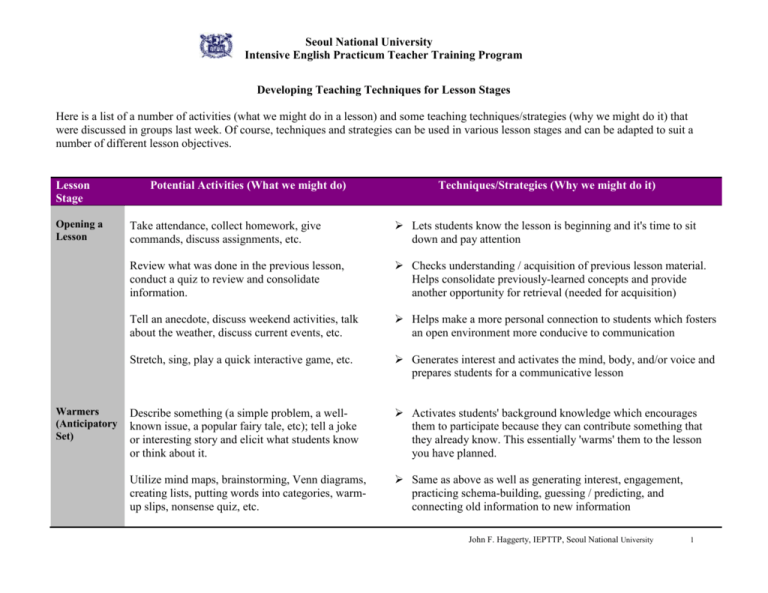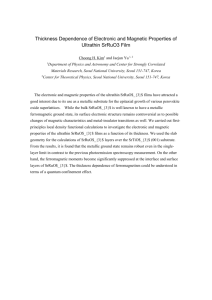List of Teaching Techniques (by lesson stage) File
advertisement

Seoul National University Intensive English Practicum Teacher Training Program Developing Teaching Techniques for Lesson Stages Here is a list of a number of activities (what we might do in a lesson) and some teaching techniques/strategies (why we might do it) that were discussed in groups last week. Of course, techniques and strategies can be used in various lesson stages and can be adapted to suit a number of different lesson objectives. Lesson Stage Opening a Lesson Warmers (Anticipatory Set) Potential Activities (What we might do) Techniques/Strategies (Why we might do it) Take attendance, collect homework, give commands, discuss assignments, etc. Lets students know the lesson is beginning and it's time to sit down and pay attention Review what was done in the previous lesson, conduct a quiz to review and consolidate information. Checks understanding / acquisition of previous lesson material. Helps consolidate previously-learned concepts and provide another opportunity for retrieval (needed for acquisition) Tell an anecdote, discuss weekend activities, talk about the weather, discuss current events, etc. Helps make a more personal connection to students which fosters an open environment more conducive to communication Stretch, sing, play a quick interactive game, etc. Generates interest and activates the mind, body, and/or voice and prepares students for a communicative lesson Describe something (a simple problem, a wellknown issue, a popular fairy tale, etc); tell a joke or interesting story and elicit what students know or think about it. Activates students' background knowledge which encourages them to participate because they can contribute something that they already know. This essentially 'warms' them to the lesson you have planned. Utilize mind maps, brainstorming, Venn diagrams, creating lists, putting words into categories, warmup slips, nonsense quiz, etc. Same as above as well as generating interest, engagement, practicing schema-building, guessing / predicting, and connecting old information to new information John F. Haggerty, IEPTTP, Seoul National University 1 Seoul National University Intensive English Practicum Teacher Training Program Direct Instruction Play short video clips (with or without sound), show a cartoon, show an interesting image, realia, etc. Same as above as well as providing real-life content, encouraging creative thinking, and incorporating visual input Having students guess or predict the theme of lesson or the lesson objectives Generates interest, creative thinking, and anticipating future information based on available information Have students make sentences with words previously learned that are also linked to activities to follow Consolidates and provides an opportunity for student to apply previously-learned information Play an educational game – eye contact game, flashcards, Scrabble (word search), hangman, Cryptomania, Jeopardy, riddles, anagrams, problem-solving activity, etc. that is linguistically or thematically linked to future activities Generate interest and promotes problem-solving, schemabuilding, time-intensive recall, etc. Can also provide a routinized activity that is easily used once the game is understood. The content for this game should be connected to the lesson objectives in some way in order to properly be called a warmer. Praising and encouraging student responses whether correct or incorrect – this occurs throughout the lesson. Creates a safe environment for students to take risks while attempting to communicate in the L2. This reduces the affective filter and increases students' willingness to communicate. Explain lesson objectives in terms of what students will be able to do (SWBAT) Provides students with a rationale/purpose for paying attention and participating in lesson activities. Drilling new target language to improve pronunciation and memory. Gives students needed practice to develop their accuracy which improves confidence in the L2. Present target language using PPT, flashcards, handouts, dialogues, whiteboard, textbook, etc. Provides a structured and contextualized method for student intake of new language forms – necessary for acquisition. Teach new target language and/or skills as simply as possible utilizing a variety of auditory, visual, and kinesthetic channels (including modeling) Provides learners a way to understand new language through greater contextualization and helps prepare them to complete lesson activities more successfully John F. Haggerty, IEPTTP, Seoul National University 2 Seoul National University Intensive English Practicum Teacher Training Program Guided Practice Use visual aids (e.g. a timeline, a Venn diagram, categories, pictures, video clips) to present new information to students Maximizes schema-building and contextualizes new information through visual aids. Present new target language using an inductive approach (with scaffolding). For example, writing sentences on the board and have students notice the target language themselves as much as possible. Then teach the TL using a deductive approach. Provides an opportunity for students to notice new vocabulary or grammatical patterns on their own (or with the assistance of more capable others). This can help promote scaffolding (Vygotsky's ZPD) and encourage more autonomous learning. Use concept-checking questions to follow-up direct instruction and assess understanding (this occurs throughout the lesson whenever needed) This helps to assess the success of the direct instruction and how much the students truly understand. Without this check, the activities that follow may not work well. Have students put sentences (at the sentential or paragraph level for writing) or spoken utterances (for dialogues) in the correct order. Provides an opportunity for students to connect previouslylearned information to new information through re-construction of discourse. Assists in the development of natural discourse. Have students (individually, in pairs, or in groups) figure out the answers to teacher-made questions Provides a specific purpose for reading or listening and develops important academic skills that will be needed in the future. Have students read or listen to lesson content to develop a particular skill (e.g. skimming / scanning), reading for a purpose (e.g., gist/specific information), or comparing and contrasting (e.g., what was heard vs. what was read) Same as above as well as providing an opportunity to practice a variety of skills with the same lesson content. This reinforces understanding of the content from a variety of perspectives and helps students develop specialized skills for these purposes. Play an audio/video clip or give out reading text and give students a task to complete (e.g., cloze test, dictation, categorizing, noticing specific words, etc). Provides students a structured and scaffolded method for practicing comprehension of lesson content. John F. Haggerty, IEPTTP, Seoul National University 3 Seoul National University Intensive English Practicum Teacher Training Program Freer Practice Have students complete a table, chart, Venn diagram, or a graphic organizer of some kind with information extracted from lesson content Provides an opportunity for students to organize information which assists schema-building. This can assist greatly in student's ability to recall in the future. Conduct a (limited) information-gap activity for practice and reinforcement of what was learned in direct instruction Allows students to exchange information with others within a structured format. This helps to scaffold their linguistic and communicative competence. Conduct a controlled writing activity using an explicit structure of some kind that the students can follow (e.g., AABB poetry, formal letters, 5paragraph essay, etc). Allows students to practice writing in a semi-structured format based on high-order L2 writing principles. This helps to scaffold understanding of various L2 writing expectations (genres). Monitor the activities being completed by students as much as possible. Respond to issues that occur during activities to ensure students remain on task. This is the primary way that teachers assure that their instructions are understood and students know what to do. This should happen during any student activity as much as possible. Check understanding of TL through conceptcheck questions when wrapping up this stage and moving on to the next stage. A variety of concept-check questions help students consolidate information and make a transition to the next activity. Conduct an information-gap, interview, roving reporter, or a 'guess who' activity for students to practice communicating in the L2 This allows students to more freely exchange information with their classmates and gives them a purpose to extend communication whenever possible. Have students create something (e.g., a role play, a written dialogue, a poem, a mosaic story, a short story, a character chart, etc) This promotes freer expression and creativity in the L2. It raises the level of challenge for students which can increase its interest for students who are ready for it. Have students create questions based on a reading or listening text for other students to answer This maximizes students' opportunity to apply their creativity in the L2 and can encourage independent/autonomous learning. John F. Haggerty, IEPTTP, Seoul National University 4 Seoul National University Intensive English Practicum Teacher Training Program Closing and Assessment Have students create an alternate ending for a story and vote for the most original ending (or compare endings to the actual ending). In addition to fostering creativity, this allows students to practice extending discourse logically and coherently as well as considering cause/effect relationships. Have students compare and contrast information from lesson content based on categories they choose. Promotes a higher understanding of organization concepts and the complex connections that exist between related ideas. Hand out a picture (or a series of pictures) for student to create their own stories or dialogues. Permits interpretation of visual input and the free expression or connected ideas. Allow students to write freely about a topic that interests them and share this with a classmate Maximizes opportunities for target-like language production. Conduct a debate about an issue that is of importance to students. Gives opportunities for students to organize ideas, practice formal speech, and develop more persuasive oral skills. Facilitate a 'readers' theater' or 'literature circle' to encourage more discussion about reading content. Develops cooperative and collaborative skills in the coconstruction of meaning. Have students present the results of their activities in from of the class. Develops formal presentation skills and allows teachers to assess the success of their objectives and the progress being made by students. Use concept checking questions (yes/no, true false, multi-option), short quizzes, interactive games like Jeopardy, an 'exit slip', or any other method intended to assess the success of lesson objectives. This helps to consolidate the information that students have learned and practiced. It provides an additional way for teachers and students to assess the success of the lesson objectives. It also helps teachers to determine what might need to be reviewed and practiced in future lessons. John F. Haggerty, IEPTTP, Seoul National University 5 Seoul National University Intensive English Practicum Teacher Training Program Conduct a teacher-led activity that allows students to apply what they have learned in a different context (e.g. students instruct the teacher how to do something) This provides a more real-life way of concept checking that allows students to see the utility of the target language in real-life situations. This can help assess the ability of students to apply newly-learned target language or skills. Assign a homework assignment (task-based) or a homework quiz in order to extend the lesson objectives and further assess acquisition / uptake of TL. This provides an opportunity for student to extend application of newly-learned information and provides a further way for teachers to assess lesson objectives and the progress of students. Anticipate future lesson content. Provides a sense of course flow for students and encourages teachers to consider how their lessons might be building knowledge and skills for students. Of course, this is only a brief list of potential activities that could be done in a communicative lesson – there is literally no limit to how many activities that could be added. However, you should begin to realize that the rationales behind many of the activities are often the same and there is quite a lot of overlap. The reality is that there will always be new communicative activities being created, but their value will always be determined by how successful they are in getting students to participate in the class, and by doing so, improve their communicative ability. Keep looking for new activities, but always consider the rationale for using them before incorporating them into your lesson. If you have established good rapport with your students, created a safe classroom environment that encourages open communication, and explicitly connected the communicative activity to useful and meaningful lesson objectives and content, then you are far more likely to get students speaking and writing in the TL and will have successfully delivered a communicative lesson. So, let's get them communicating! John F. Haggerty, IEPTTP, Seoul National University 6
![[Slogan] Proposal for Seoul Brand Idea Contest](http://s3.studylib.net/store/data/006838769_1-d7653e11f28783f70bcf6bf0f4022941-300x300.png)








